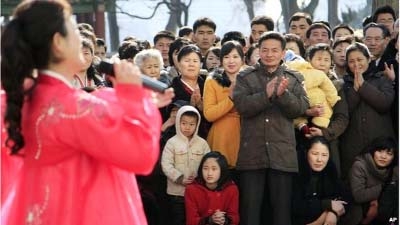
BBC Online :
North Koreans have been voting in a five-yearly election to approve members of the rubber-stamp parliament, the Supreme People’s Assembly.
Each of the 687 districts has only one candidate running for office, with electors required to write only “Yes” or “No” on the ballot paper.
Campaign posters across the capital, Pyongyang, have urged a “Yes” vote.
Observers say the candidate list is an opportunity to see who is in or out of favour with the leadership.
The North Korean vote is a ritual, the result of which has already been largely determined.
The Supreme People’s Assembly meets rarely and has very little power but you would not know it from the official turnout. There is only one candidate for each district, and one name on each ballot paper. The democratic duty for the electorate is simply to write “Yes” beside it. Writing anything else might be seen as treachery, rather than democracy.
That is especially true if you live in the district of Mount Paekdu – the constituency of current North Korean leader, Kim Jong-un. State media have devoted entire reports to the excitement of voters at the Mount Paekdu polling station, on seeing his name on the ballot paper.
The only real value in these polls, analysts say, is in watching for any signs of change in the list of state-approved candidates.
In the last election in 2009, turnout was 99%, with 100% of votes in favour of the given candidates.
The election is the first to be held under the leadership of Kim Jong-un, who came to power in December 2011 after the death of his father, Kim Jong-il.

